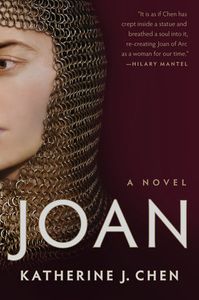 Fiction alum Katherine Chen (Fiction ’21)’s second novel Joan was released today by Random House! In celebration of the book’s release, current program administrator Annaka Saari (Poetry ’21) was able to briefly interview Katherine via email. Read below to hear Katherine’s thoughts about the difficulties of writing a second novel, the processes of writing and revision, and the similarities between writing fictional and historical characters.
Fiction alum Katherine Chen (Fiction ’21)’s second novel Joan was released today by Random House! In celebration of the book’s release, current program administrator Annaka Saari (Poetry ’21) was able to briefly interview Katherine via email. Read below to hear Katherine’s thoughts about the difficulties of writing a second novel, the processes of writing and revision, and the similarities between writing fictional and historical characters.
Annaka: I’ve heard many times that the second novel is harder to write than the first. Did that hold true for you?
Katherine: I think this is generally true. I do think, however, that the subject of my second novel was more difficult and also more elusive, and that this contributed to the overall feeling of difficulty as well.
A: Were there any major differences in the way you approached the writing and revision of this novel as opposed to the way you approached your first?
K: For the first novel, I always felt like I was writing against time. Everything seemed to be in more of a hurry. With the second, I spent more time researching, then wrote a manuscript that was around 200,000 words, and eventually scrapped it. Then I started from page one. Nothing from the first version really transferred over. I just had to begin again. I think that was the main difference. And when I revised the second version, it was almost like going through the process of rewriting it again. I probably rewrote half of it, then rewrote a third of it, a quarter of it, until it felt right. There were more rounds, and even in the later stages of editing, I was still adding in new scenes and making changes. The writing and revision process for the second novel definitely took longer and felt more intensive.
A: Your first novel, Mary B, focuses on the experiences of Mary Bennet, the middle sister in Jane Austen’s Pride and Prejudice. In Joan, your protagonist is another already-existing figure, but this time one from French history: Joan of Arc. What was it like to write characters whose roots are already established, and how did you find writing a character from history to be different from writing a character from a famous work of fiction?
K: This is a good question. I think the process of writing is probably not that different. In the case of the first, the source material, as you have pointed out, is a novel. With the second, the source material can be many things, such as biographies of Joan of Arc, transcripts from Joan’s trial and retrial, books on the Hundred Years’ War, etc. As for actually writing about the characters, I don’t think the process is that dissimilar, because you’re still trying to find something new to say about a character who already exists. With Joan, I found that to be a tall order, which is probably why the first version of the novel was thrown out. I had originally approached the book with a mental checklist of historical events, and the end result was a prose version of a historical timeline, which doesn’t make for a very readable book. I think with any character who is already known to many people, both the question and the challenge is why you are writing this novel and what you want the work to say that hasn’t already been said.
Those interested can purchase Joan at this link.
